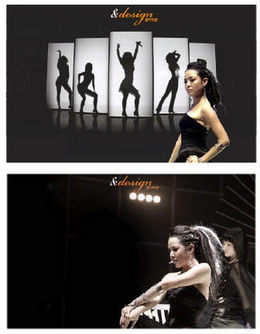Posted on : Jan.15,2007 15:14 KST
Modified on : Jan.16,2007 15:02 KST
 |
|
A scene from Anystar
|
Full-length online versions add to new advertising boom
Two songs sweeping the music charts these days have several peculiar things in common. They can be heard only if you turn on the TV. The reason? They are songs featured in commercials: One is mobile service provider KTF’s tune "&design" (pronounced "endijain"), featuring film actress Mun Geun-yeong taking a shot at singing, while "Anystar" features top female pop singer Lee Hyo-ri crooning for Samsung Electronics.
The songs’ popularity represents a breakdown of the usual barrier between popular and commercial songs. In the past, commercial songs have usually borrowed melodies from popular songs in order to appeal to trend-savvy consumers.
Things, however, started to change in 2005 when the commercial music video "Anymotion" made a huge splash. The video, starring Lee Hyo-ri, was made as a commercial for Samsung Electronics’s handset model "Anycall," and it ushered in a new era of blurred lines between commercial and popular songs.
At first, "Anymotion" was initially banned from being aired on TV other than in commercial form because broadcasting authorities evaluated it as a commercial song. But it gained popularity in a short period of time through exposure via TV commercials and Internet advertisements, and also because many radio listeners requested stations to play it. Then, it began popping up as a background song on several prime-time TV serials.
 |
|
Scenes from &design
|
The latest two hit songs - "&design’ and "Anystar" - are based on the model of success set by "Anymotion." In fact, all three hit commercial songs were penned by musician Park Geun-tae, known for his work on singer Baek Ji-young’s "No More Love" as well as the group SG Wannabe’s hit, "Timeless."
The success of such commercials songs is contributed mainly to an advertising strategy based on so-called "cross media," or combining the popularity of television and the Internet. To fully take advantage of these two media, two different versions of the songs were prepared - a shorter one for TV commercials and a full-length version for the Internet.
For example, "Anystar" has its short TV manifestation as well as a nine-minute music video version on the Anycall homepage. KTF’s "&design" offers a six-minute music video available for download through the company’s online music site Dosirak. All of these efforts are aimed at appealing to the younger generation that makes up a large part of these companies’ consumer base.
Commercials songs’ success represents an ongoing change in the way people enjoy music. Though some experts have raised concerns over this recent category shift, many agree that it is rare for commercial songs to be popular enough to merit such "crossover" status. Other experts are impressed by such effective product advertisement.
Music critic Park Jun-heum is in the former camp, saying that commercial songs do not belong to the popular-song category. "Commercial songs were made for a a particular purpose, and not for being unveiled as part of a music album. Further debate is needed before we include such ’function-oriented’ songs into the category of popular song."
Lee Jin-mo, another music critic, said that the latest examples show that traditional marketing and distribution channels for songs are breaking down, with the emergence of innovative methods using new media. "There will be more of such cases down the road, as people get more interested in digital markets over the existing CD-based production methods."
Please direct questions or comments to [englishhani@hani.co.kr]







